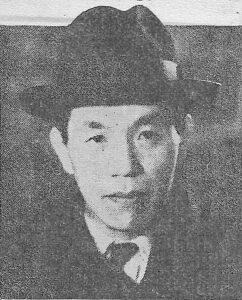
(From the March issue that year of Shinko Cinema, published by Eikosha)
“Yes, it has been a bad dream… but a beautiful one will begin.’ So ends Monna Vanna, a 1902 drama by Belgian playwright Maurice Maeterlinck. The phrase influenced Akira Nobuchi (1896-1968) so strongly that he contributed a short essay to his graduation yearbook, which ends as follows:
“Real life will begin.” As Vanna cries out at the end, this is nothing less than my voice.
A high school student from Nara Prefecture, Nobuchi began his real life in Kyoto, after he was admitted to Doshisha University for theology studies. In 1916 he stopped studying there, however, and entered Kyoto Imperial University (now Kyoto University) to deepen his knowledge of English literature, in particular Irish dramatist John Millington Synge whose play The Shadow of the Glen (1903) the undergraduate chose for his graduation thesis.
Nobuchi started his stage management career from around the time of his graduation in 1919. During the next fourteen years, he helped shingeki (Western-style drama) thrive in Kyoto Prefecture and neighboring areas while Tokyo experienced a similar theatrical change led by influential figures such as literary critic Hogetsu Shimamura, actress Sumako Matsui and authors Shoyo Tsubouchi and Kaoru Osanai. Nobuchi headed his own drama troupe Elan Vital Shogekijo, and they performed mainly at theaters in Kyoto, not only plays by Japanese dramatists but also Western counterparts including Arthur Schnitzler, Lady Gregory and Lord Dunsany.

Among the presentations was Juno and the Paycock (1924) by Irish playwright Sean O’Casey, which was performed at the Okazaki Kokaido hall (predecessor of the Kyoto City Museum of Art Annex). This was the earliest show of the play in Japan. Nobuchi also performed the drama at the Pontocho Kaburenjo theater, which was completed in 1927.
The year 1927 also brought him a meeting with future actress: Takako Irie (1911-95). She was introduced by her brother to Nobuchi, who cast her in such plays as Uncle Vanya by Anton Chekhov and The Living Corpse by Leo Tolstoy. Some of her performances were seen by film director Tomu Uchida, who enabled her debut as a movie star in 1928.
However, Nobuchi suffered from various problems, ranging from poverty to censorship. There was also the rise of proletarian dramas from 1929. Nobuchi chose to leave the Elan Vital in 1933 and went on to make a foray into filmdom the following year by joining the Shinko Cinema. One of its studios was based in Kyoto, and Nobuchi’s first film was a talkie released in Nagasaki Ryugakusei.
At this time Kyoto was a centre of film making and known as “Japan’s Hollywood”. Nobuchi contributed 32 films, from his maiden work to his swan song Kaidan Botan Doro (Peony Lantern Kaidan) in 1955. At least 22 pieces were shot at studios in Kyoto. Many of the motion pictures put an emphasis on actresses and their beauty, as well as meiji-mono, or films that re-enact the atmosphere of the Meiji Period. He succeeded in both genres, notably Yoshida Goten in 1937 and Fufu Nise in 1940. The former, giving prominence to the flamboyant ambiance and the magnetism of femmes fatale, became particularly popular, as filmmaker Kaneto Shindo recalls in a 1993 book Shinko Cinema Senzen Goraku Eiga no Okoku (Shinko Cinema: The Kingdom of Entertainment Films).
Among the large number of actresses to become famous was People’s Honor Award-winning actress Mitsuko Mori (1920-2012). About half a century later, she recalls the experience:
Since it’s natural that male actors play a leading role, few taught acting to female actors except for one person – film director Akira Nobuchi who kindly told me, ‘Acting is learnt through form.’
(Nihon Keizai Shimbun, December 8, 2007)
It goes without saying that Nobuchi suffered from the growing censorship just before and during World War II. At least two of his films fell victim – the 2,000mm film of Murasaki Shikibu (Lady Murasaki, 1939) was cut by 40 percent, and he was forced to add changes to his 1943 work Hozutsu no Hibiki (Vibrancy of Artillery).

Japan’s defeat in the Allies-Axis war was followed by the loss of Nobuchi’s mother in September of the same year (his father had died in June 1934, a few months before his son’s debut as a filmmaker). In 1946, however, he resumed shooting films, directing stage plays, writing for magazines and creating his own original works. The years 1949 and 1950 were marked by revival of the Elan Vital at some of Kyoto’s theaters, and he also worked with the Shochiku Shinkigeki comedy troupe, which performed a dozen plays of his at theaters including Minamiza. In addition, he worked with Gion Higashi, one of Kyoto’s five geisha quarters, in the autumn of 1952.
On February 1, 1968, pneumonia took the life of Akira Nobuchi. He still lives on in the memory of shingeki researchers and fans of early Showa Period movies (also I hope of those who kindly read this article). If this write-up interests you, I humbly recommend you to visit Kyoto Prefectural Library and watch video editions of his post-WWII films Koi Jamisen (1946), starring actor Kanjuro Arashi, and Taki no Shiraito (1952), which features Machiko Kyo and actor Masayuki Mori.
****************
For Nobuchi’s IMDb page, please click here. For details of six of his films, see here.

